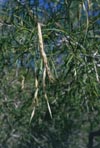Home >
Chilopsis linearis, Desert-Willow
Desert-Willow should be grown in full sun and is extremely drought-tolerant although it responds to summer irrigation in the drier climates with nice growth, a full canopy, and flowers. While the trees will grow and flower better with adequate moisture, they will probably not tolerate over-watering, especially in eastern North America. Plant in raised beds in regions receiving more than 30 inches rainfall. Plants are native to dry washes and canyons bottoms along stream beds in the southwestern US. They are usually deciduous for no more than about 8 weeks in their native habitat. Flowers attract the carpenter bee in large numbers. In some parts of Mexico the dried flowers are brewed into a tea thought to have medicinal qualities.
Native plants occur along dry water courses and washes where roots probably manage to obtain water through the dry season from West Texas and New Mexico to California and south into Mexico. The subspecies arcuata is typically found in the western part of the range and has willow-like foliage; subspecies linearis has short wide foliage and is typical of plants in the eastern part of the range.
The multi-trunked, well branched habit of growth and thick growth make Desert-Willow well suited for a wide screen or tall hedge. Groups can be planted in a large-scale landscape for a splash of flower color. They make a great small garden shade tree or ornamental for patio. Flowers occur on new wood and can appear on trees as young as two years old. Hummingbirds enjoy visiting this plant. Plants pruned back to nearly ground level each year form a nice shrub 3-10 feet tall and flower more than a tree that is left unpruned. Avoid over-watering the plant once it is well established, or plant on a raised bed if irrigation water will fall on the root zone.
Flowers, seeds and leaves can be considered messy by some people. Seeds can sprout under the right conditions and could become weedy. The wood is weak, so be sure to prune to create good structure with no bark included in the branch crotches. Thin main branches that grow very long. Pollen can cause some allergy symptoms. National champion is 68 x 48 feet in Arizona.
Cultivars include "White Storm', 'Dark Storm', 'Marfa Lace', 'Alpine', 'Hope', 'Tejas', 'Barranco', 'Burgundy' (no fruit) and others. 'Lois Adams' is a new trademarked cultivar with outstanding purple-red flowers and little or no pod production.






